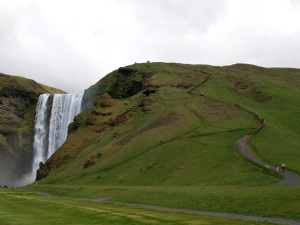They live on a volcanic island just outside the Arctic Circle, but Icelanders as a group are some of the happiest (despite some long, dark winter months and the pesky economic collapse their country recently experienced) and healthiest (they have an average lifespan of 81, one of the longest anywhere) people on earth. I’m sure part of this can be attributed to living in a singularly beautiful place, year-round swimming in geothermal-heated hot springs, and having some really cute guys (and girls) to go out with. But that can’t really be it. I think it’s the food.
Because of its isolated location and strict government guidelines (Example: When my flight landed in Reykjavik, I had to toss my brand new, unopened bottle of Fiji water that I had just bought inside security at JFK; nothing so impure as water purchased in the grimy US of A can be brought into Iceland.), Iceland produces some of the purest food anywhere. Most Icelanders, therefore, eat a diet that is local, clean, and packed with nutrients like beta carotene (milk and cheese from grass-fed cows) and omega-3 fatty acids (wild salmon from glacier-fed rivers). Plus, the country of Iceland is home to exactly zero McDonald’s. Imagine.


I visited Iceland last summer and got to eat like an Icelander for a week. Probably not long enough to experience any lasting health or happiness benefits. But I can tell you the food was a huge surprise. I had expected something like the meals described in “The Girl with the Dragon Tattoo,” i.e. lots of pickled vegetables, salty fish, and rye bread. Unlike what they apparently eat in Sweden, the food in Iceland is fresh and delicious — and that even includes the lamb hot dogs we sampled in Reykjavik on Jonas’s famous free tour.
It’s not really in the spirit of eating locally to recommend a diet of Icelandic imports, but I think there’s a valuable takeaway here anyway. While we in the U.S. may not be able to eat exactly what Erlingur and the rest of the 317,000 people in Iceland eat, we can learn from the way they produce food and keep it in mind when deciding whether or not to ingest that gorgeous pink (it’s dyed) farm-raised Atlantic salmon — which is probably contaminated with PCBs (aka toxic industrial compounds), by the way.

- Fish
In Iceland, I was told many times by many people (including our guide, whose name was Erlingur), the water is so pure, you can drink from the streams. So I did. And I wasn’t even especially thirsty. The Icelandic government banned fishing for (endangered) North Atlantic salmon (in the ocean), but fishermen do pull lots of fat, naturally pink wild salmon out of the rivers there (with fishing rods); and they do still catch (again, with rods) the abundant herring, cod, and arctic char that fill the oceans surrounding the country. Probably the most popular fish, arctic char was on almost every menu I saw in Iceland. It reminded me of trout, only a little fattier and it is delicious sautéed in butter (what isn’t, right?). Icelandic fish, especially char, which is packed with omega-3s, is now available in the U.S.

- Fruits and Veggies
As my group drove along Iceland’s southern coast toward the national park we were visiting, we passed several huge greenhouses. In addition to the free and clean heating and outdoor swimming pools Icelanders get via virtually unlimited geothermal, apparently they also enjoy locally grown bananas. And lettuces, strawberries, melons, you name it.
- Lamb
No question, the lamb in Iceland was the best I’ve ever tasted. The restaurant in the odd, dingy hotel we stayed at near the national park offered a menu item called “Lamb Fantasy” or maybe it was “Lamb Festival,” but most of my group ordered it, and it really was a festival and a fantasy. The lamb was extremely tender, not fatty, and had an especially divine but not overwhelming lambiness. Lambs in Iceland may not have a long life, but they have a happy one. They graze freely in bright-green pastures during the country’s 24-hours-of-sunlight summers — so they get to eat a lot in a short time and don’t ever need to be fattened up with grain or fillers. This lamb is almost as high in omega-3s as salmon. Apparently it is exported in very limited quantities.

- Dairy Products
The French have their terroir — some say they can tell you exactly which vineyard produced the grapes in a specific bottle of wine. Icelanders claim to be able to do this with their dairy products, which, due to strict import and environmental regulations, are locally produced on small family farms. Just about every farm’s cheese is unique. And the beta-carotene–rich butter is varying shades of yellow, depending on which local grasses the cows have been eating.
My favorite Icelandic dairy product is skyr, a yogurt-like cheese that Icelanders have been eating since at least the 9th century. To make skyr, you skim the cream off milk (to make butter of course), and then strain the whey from the remaining skimmed milk. What’s left is a thick and creamy cheese that is similar in consistency to Greek yogurt but with no fat. At 16 grams per 6 oz., Skyr has more than twice the amount of protein as typical American yogurt. It’s the most popular fast food (and snack food) in Iceland; hey, maybe that alone is the secret to the population’s general good health?

The best news? Icelandic Skyr is making its way across the U.S. Last summer after I returned from Iceland, I looked for it and could only find the Siggi’s brand, which is made in New York state; it’s good but not quite the same as the addictive stuff they’ve been making in Iceland for 11 centuries. I even emailed the (Icelandic) Skyr manufacturer and was told they were starting to import to the U.S. beginning with the northeast (Boston, New York) and gradually heading west and south. Well, guess what I found at my local Whole Foods a couple months ago? It should be all the way to California by now. All I can say is, try it.

Oh my gosh! What an awesome post! I learned so much, loved your travel photos, got inspired and now have something new and exciting to look for on my next trip to Whole Foods. Half way through me reading your article, my husband called to tell me he was going to the store and mentioned Salmon from Costco plus these tiny canned clams he buys to make this one lemon fish recipe he invented before I met him. You should have heard me trying to convince him the cans are poisonous and the fish is dyed. LOL. He said, where the heck are you getting all this stuff from? I said…”The Food Evangelist” of course. “Who’s that?” he replied. Only the most knowledgeable real life woman I know who has already taught me so many things about food that I didn’t quite understand, despite how much I do read and make attempts to do the right things. So, long story… Thank you!
Thanks Barb! Believe me, I know that salmon looks and tastes fantastic, but I think you need to stick with wild, which they do carry at Costco — only it’s frozen. I fear your spouse is going to hate me…(and he’s probably not the only one!)!